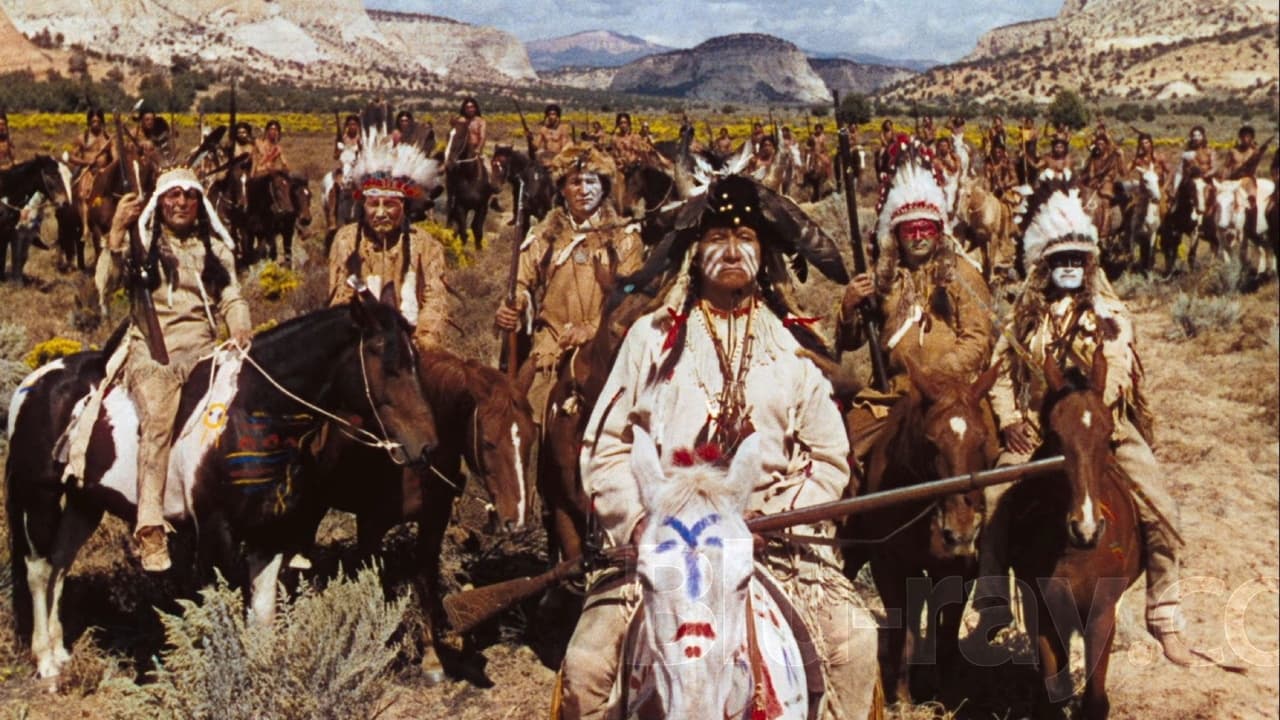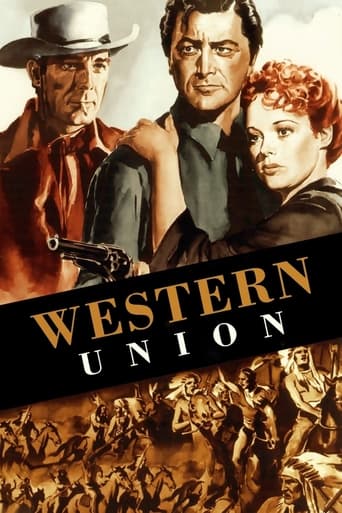


Purely Joyful Movie!
... View MoreI didn’t really have many expectations going into the movie (good or bad), but I actually really enjoyed it. I really liked the characters and the banter between them.
... View MoreGreat example of an old-fashioned, pure-at-heart escapist event movie that doesn't pretend to be anything that it's not and has boat loads of fun being its own ludicrous self.
... View MoreThe storyline feels a little thin and moth-eaten in parts but this sequel is plenty of fun.
... View MoreRandolph Scott (Vance Shaw), Robert Young (Richard Blake), Dean Jagger (Edward Creighton), Virginia Gilmore (Sue Creighton), John Carradine (Doc Murdoch), Slim Summerville (Herman), Chill Wills (Homer), Barton MacLane (Jack Slade), Russell Hicks (governor), Victor Kilian (Charlie), Minor Watson (Pat Grogan), George Chandler (Herb), Chief Big Tree (Chief Spotted Horse), Chief Thundercloud (Indian leader), Dick Rich (Porky), Harry Strang (henchman), Charles Middleton (stagecoach rider), Addison Richards (Captain Harlow), Irving Bacon (barber), Francis Ford, Eddy Waller (stagecoach drivers), James Flavin, Frank Mills, Ralph Dunn (men), Paul E. Burns (Bert), Cliff Clark, Hank Bell.Director: FRITZ LANG. 2nd unit director: Otto Brower. Screenplay: Robert Carson. Based on the 1939 novel by Zane Grey. Photographed in Technicolor by Edward Cronjager and Allen M. Davey. Film editor: Robert Bischoff. Art directors: Richard Day, Wiard B. Ihnen. Set decorator: Thomas Little. Costumes: Travis Banton. Music director: David Buttolph. Technicolor color consultants: Natalie Kalmus, Morgan Padelford. Associate film editor: Gene Fowler Jr. Sound recording: Bernard Freericks, Roger Heman. Western Electric Sound System. Associate producer: Harry Joe Brown. Executive producer: Darryl F. Zanuck.Copyright 21 February 1941 by 20th Century-Fox Film Corp. New York opening at the Roxy: 6 February 1941. U.S. release: 21 February 1941. Australian release: 29 January 1942. 8,602 feet. 95 minutes.SYNOPSIS: Despite Indians and outlaws, Western Union constructs a telegraph line from Omaha, Nebraska, to Salt Lake City, Utah.NOTES: Although Irving Bacon is credited as Joe, the barber, in the credits of the print under review, the part — in this version at least — was played not by Bacon but by Olin Howland. These credits also state that the art directors were Richard Day and Albert Hogsett. Both Wiard B. Ihnen and 20th Century-Fox dispute this credit. Both maintain that Mr. Hogsett had nothing to do with the sets for Western Union and that they were in fact designed by Ihnen, under Day's general supervision. COMMENT: A really memorable western which fully justifies its high reputation. Spectacularly produced, with action a-plenty, agreeably acted, superlatively photographed, with lots of forceful Lang touches in direction. From the opening credits, underlined by Buttolph's stirring score, through the opening shot of the buffalo with Scott (or at least his double) hard riding into their midst, the pace hardly ever lets up until the final unexpected fade-out. Aided by marvelous color photography, the clever script (which actually owes little but its title to the Zane Grey novel) introduces at least six or seven rousing action episodes. All built around some particularly daring stunt-work. Good to see Robert Young doing a fair bit of his own riding, but most impressive of all is Dean Jagger, caught making his own leap from an overturning wagon. Of course, Jagger, aside from this action spot, is much his usual limp blanket, but at least he isn't in the movie all that much. Also slightly on the negative side of the cast roster is Virginia Gilmore, a little too postcard pretty, in my opinion, to be wholly believable. Lack of credibility is certainly not a charge that can be leveled against Randolph Scott who is every inch your typically laconic, torn-twixt-love-and-duty western hero. Unlike Gilmore, Scott really looks the part. Young is effective too. Slim Summerville is along for comic relief. Whilst some of his antics are a trifle forced, we like Slim anyway. A bearded (and unrecognizable were it not for his distinctively rich voice) Victor Kilian makes a surprisingly effective stooge.Led by John Carradine (made up to look like the Henry Hull character in "Return of Frank James"), many of our favorite character actors can be spotted along the way, including the here ill-fated Chill Wills (in a straighter part than usual); Francis Ford as the stage driver with whom Summerville tries to escape; James Flavin as a member of the bank hold-up posse; Russell Hicks as a governor reduced to horse holder; George Chandler as the victim of an "Indian" attack. Best of all is Barton MacLane as the notorious Jack Slade whose humor is strained by his kinship with our hero. In an interview with Peter Bogdanovich, Lang remarked that audiences tend to remember the visual aspects of a film rather than the dialogue. I'm inclined to agree with this observation, yet there's a scene in Western Union which amply demonstrates Lang's mastery of both. Kilian bets Carradine a week's wages that Chandler won't last the night, despite the doc's best efforts to save him. Later, Carradine silently exits his tent, peels off a wad of notes into Kilian's waiting hand, and without a word slowly walks off. Kilian cheerfully calls after him: "Better luck next time, Doc!" Lang tops all the spectacular action with a suspenseful double climax which ends the movie on a totally unpredictable note. OTHER VIEWS: The best of Fox's traditional western epics. — William K. Everson.The most beautiful and epic of Lang's westerns (it was the director's personal favorite), "Western Union" is an outstanding entry in the genre. — Motion Picture Guide.
... View MoreFair to say I didn't like it much as some other people. It was just too common. This was all things you have seen before and not done too well either. It's the classic nice guys walk around jolly and laugh at a lot with some silly humor thrown in here and there and a bit of shooting and of course the obligatory ending you knew from the start.Very poor and stagy acting. Rather common for a lot of 30's and 40's films but still. The plot jumps all around and there's next to no build up. Something is thrown out, then it's resolved or forgotten. Also all these characters have been in so many films before and after that it's rather sad.It had a few good scenes though, love the magic wire scene with the Indians. Some of the "oh so cute, lol" scenes are enjoyable of course and of course Lang isn't a bad director so he did manage to pull it together, BUT this is by far his worst film IMO. from me.
... View MoreLang does Hawks as well as Hawks does in the first part of this extraordinary Western, before settling down into typical deterministic, dark and guilt-haunted Lang for the finale.This is one of those films that shows its greatness almost instantly but at the same time very subtly. Vance Shaw (Randolph Scott) is on horseback and being pursued, we know not why -- he stumbles on wounded Edward Creighton (Dean Jagger) and decides to take his gun and horse, but discovering that Creighton is in a bad way, decides to fix him up first. This is conveyed mostly through facial expressions and very brief, clipped dialog - in 2 minutes we know that Shaw is an outlaw, but basically a good guy. Shaw ends up helping Creighton on his way to civilization, then disappears.Cut to a few weeks or months later, with Creighton on the mend and in charge of an expedition to lay telegraph wire going west from Omaha. He hires Shaw as a scout, who tries to leave when he finds out that Creighton is in charge; but Creighton wants him anyway, repaying a debt and sensing something quality. Also hired is a tenderfoot, son of a benefactor of the project, but atypically the Easterner Richard Blake (Robert Young) is quite competent as he shows right away in an amusing but exciting bronco-busting sequence. Both of the hires vie for Creighton's sister Sue (Virginia Gilmore) who - again not typically - seems quite as able to take care of herself as any man. The camaraderie between the three men, the comedic elements involving an unwilling cook and various rough and tumble types, and the wonderfully played light romantic elements dominate the first third of the film and reminded me more of Howard Hawks' "Red River" or "Only Angels Have Wings" than most Lang - but they are so well played and the action progresses so naturally that it doesn't matter, and doesn't alter our pleasure - if it does perhaps change our expectations - as the more usual Langian themes of the haunted past, dark secrets and the immense pull of the easier, destructive and evil ways come to dominate the later part of the film. Shaw's old pals come back to haunt him as the the wagon train and its wires move westward; attacks mount on the crew, and Shaw has to wrestle with what, if anything, he is to tell Creighton about his tortured relationship with Jack Slade (Barton MacLane), leader of the outlaws.Beautifully shot in early Technicolor and moving fairly seamlessly from sound stages to western locations, this is for my money easily Lang's best western and one of his very best films, conveying as potently as any of his films the tragic inability of men to escape their pasts and build a new future. Scott is as good as I've seen him, showing more with a flick of an eye than a lot of actors can do in a paragraph of dialog, and the rest of the cast is uniformly fine. The inevitable showdown between Shaw's past criminal life and his potential future is extraordinary, and a surprise even for a longtime Lang devotee such as myself; and even in 1941 it seems there was no place more fraught with meaning on the margins of civilization than the barbershop and the dusty street outside. You can get a shave, you can feel like a new man, but you can't really ever be one as long as the old ties are still holding you back.Genius.
... View MoreHard to believe this was directed by Fritz Lang since he mostly directed crime dramas and mysteries. This movie has a cast that includes Robert Young, Randolph Scott, Dean Jagger and John Carradine. Scott plays an outlaw who tries to go straight and leave his old gang and winds up saving Jagger's life. Jagger works for Western Union, a telegraph company that plans to have telegraphs out west. Jagger hires a lot of men to make sure it is done because they have to worry about Indian attacks and bandits. Scott is in charge of the men and Young is a telegraph expert who can't shoot a gun but can ride. Scott meets up with his old gang who want to stop them but Scott can't tell anyone. It's a pretty good western and Lang should of directed some more westerns.
... View More